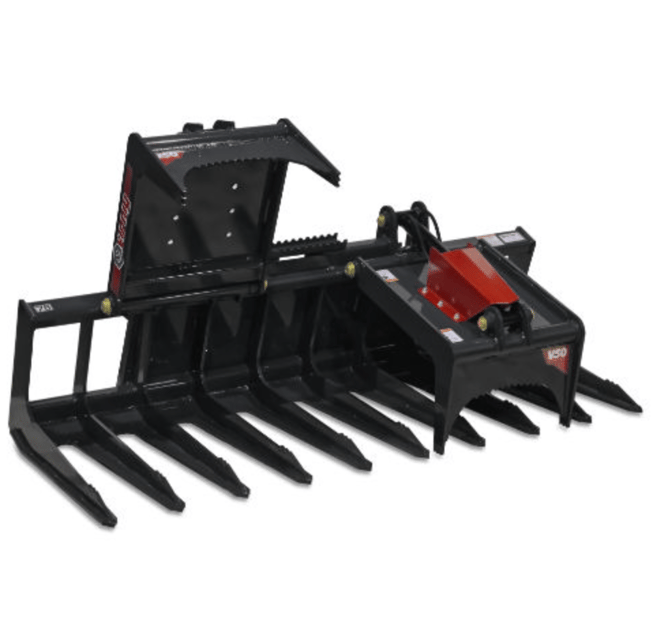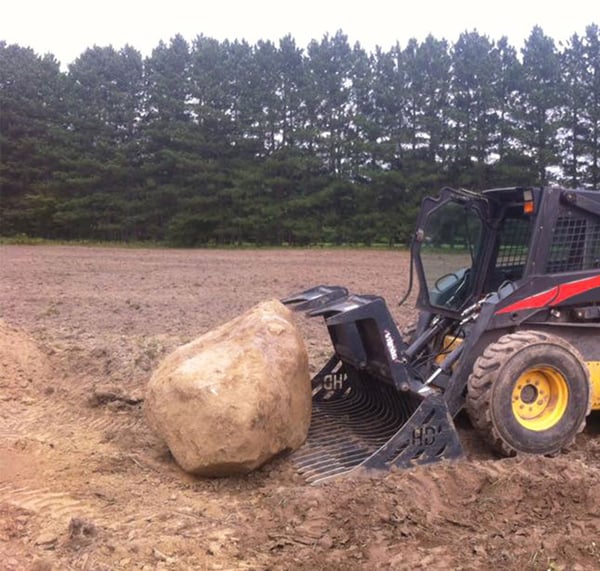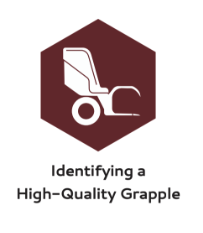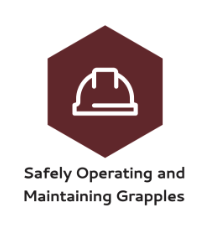When looking for a grapple attachment suitable for your needs, there are many things to consider besides price. While it may seem like any grapple will work, that couldn’t be further from the truth. Several important factors should impact your decision. This guide will help you find a quality grapple that best fits your needs while getting the most out of your investment.
Determining Specific Needs
When shopping for a grapple attachment for your skid steer, you'll be quick to realize there are many different types of grapples. Some are designed for multi-purpose use and others are designed for specific applications.
The attachment suited for your application should always be considered before purchase. For instance, people working in scrap yards will need a different grapple than people working in forests. Knowing your requirements will help you narrow down your grapple attachment choices quickly.
To narrow down what you need, start by asking yourself these questions:
- What's your application?
- What do you plan on doing with your grapple?
- Will your grapple be used for removing brush, trees, logs, manure, asphalt, concrete, scrap, or other materials?
- Will your grapple be used with two or more of the materials listed above?
If you've answered all of these questions but still aren't sure which type of grapple you need, talk to a distributor or manufacturer to get help finding the right grapple attachment.
Identifying a High-Quality Grapple
Grapple attachments endure a lot of stress, so they must be built strong in order to last a long time. A less expensive attachment might look the same, but you have to consider what decisions made that low sticker price possible:
Was it made with low-quality steel?
Are the wear parts painted instead of plated?
Does the price include cylinders, fittings, hoses, and couplers?
Often, a potential purchaser can look at a price tag and think it’s reasonable, only to later realize their new attachment is poor quality or missing vital features. Purchasing a cheap grapple that under performs or breaks when you put it to work is always going to cost you more in the long run.
Words of Advice
Most attachment manufacturers will say they have the “best quality,” making it difficult to determine who actually makes high-quality products.
When buying a grapple, we advise that you:
- Don’t pick a brand name just because you recognize the company.
- Buy an attachment based on the quality of materials that comprise it and how it’s constructed.
- Make sure you confirm the materials used in the grapple are strong and reliable.
Factors That Influence Grapple Quality
Tine Yield Strength
Yield strength measures the stress steel can withstand before it becomes permanently deformed. A minimum yield strength of 50,000 PSI should be considered. Anything less and the grapple tines may bend or break in high stress areas. The higher the yield strength, the better. Higher grades of steel increase the cost of an attachment but save time and money later.
You might’ve heard some manufacturers bring up tine diameter as a way to prove strength. A larger diameter sounds good, but tine diameter isn’t everything. For example, a 2” thick 1018 Cold Finished round stock (55,000 PSI) won’t be as strong as a 2” thick 1045 Cold Finished round stock (80,000 PSI). Even with the same diameter, these tines have a 25,000 PSI difference. Always look at the yield strength rating before looking at diameter.
Reinforcement and Steel Type
Look for extra reinforcement inside the bucket on solid bottom grapples and gussets at tine tips for skeleton style. If the tines are designed without gussets, look for thicker steel and an inverted “T” shape tine on skeleton styles like this. For round shaft style tines, refer to the PSI rating and the diameter.
Laser-Cut Steel
Laser technology offers superior cutting abilities compared to plasma. More specifically, laser cutting offers tighter tolerances, which leads to better quality. Overall, laser-cut parts are more consistent and precise, ensuring snug joints and smoother moving parts.
Cylinder Pins, Cylinder Rods, and Wear Parts
Even though these parts make up a small part of the machine, they’re extremely important. Look for parts that can easily be replaced and are easy to grease. These are wear parts, and over time they will need to be serviced and replaced. It just makes sense to make sure they’re easy to access. Quality parts and components cost a little more upfront, but they will save time and money later.
Chrome Plated Vs. Nitrosteel Cylinder Rods
Many attachment manufacturers use chrome plated cylinder rods. While these aren’t a bad choice, there are better, longer-lasting rods available for grapple attachments. NitroSteel® rods feature a dent and flake-proof protective layer chemically bonded with the steel. Not only is the finish extremely hard, it’s an environmentally friendly and superior performing alternative to chrome plating.
Grapple Styles/Options Available
Let's take a closer look a how different grapples are designed (and how they can be used).
Open Bottom vs. Solid Bottom Grapple
An open “skeleton” bottom allows smaller, unwanted material to fall between the tines. Brush grapples and rock grapples will have an open bottom that will sift the dirt and unwanted debris out.
Many skeleton grapples will have a cross member (or front comb) at the tine tips. A cross member is a piece of metal that spans across the bottom tines of a skeleton bucket to increase overall strength.
Grapples without cross members at the tine tips will allow material to be penetrated more easily than grapples with cross members at the tine tips. As mentioned above, the tines on a grapple with no cross member should be made of a thicker, higher grade of steel since there’s less structural support.
The V50 Skeleton Tine Grapple and the Root Rake Grapple are some specific examples of attachments without a cross member at the tine tips. Again, pay attention to the inverted “T” shape of the tines.
A solid bottom grapple will capture material for complete removal. With a solid bottom grapple, there are no spaces for debris to fall through. That’s what makes these types of attachments a great choice for demolition, recycling, and scrap yard applications.
Open Sides vs. Closed SideS Grapple
Grapples with open sides allow easy clamping of logs and piles of brush that are wider than the attachment. See the Virnig Skeleton Grapple.
On the other hand, grapples with closed sides or side plates keep debris from spilling out, resulting in a cleaner work area. See the Virnig Skeleton Rock Grapple.
Grapple Cylinder Guards
Cylinder guards are inexpensive insurance against damage to the most expensive and crucial part of a grapple. They prevent damage in multiple ways including: blocking dirt and debris from the cylinder rods, protecting the hydraulic fittings, deflecting heavy objects falling on the cylinder, and shielding on all four sides.
Selecting the Right Size/Width
The size of grapple you select is going to impact how quickly jobs can be completed. You want to choose something large enough to optimize the number of trips you need to take.
Choosing a grapple that’s too small means you will have to make more trips, which results in higher operating costs. Keep in mind that bigger isn’t always better. The grapple should be big enough for what you need to do, but not so big the machine can’t effectively use the attachment.
Matching a Grapple to Your Machine
Understanding Operating Capacity
Operating capacity, or lift capacity, is the total amount of weight a machine is capable of lifting. Skid steers often have operating capacities that range from 1,000-4,000 lbs. Compact tractor lift capacity is rated at the pins of the arms, and generally ranges from 1,000-1,200 lbs, depending on how the arms articulate. It’s important to note that as the operating capacity increases, the size of the machine also increases.
When lifting objects with a grapple, you also add weight. To prevent potential overloading issues, compare the machine’s operating capacity and tipping weight to the weight of the attachment, plus the estimated weight of a load. Different materials will change the estimated weight of a load. For example, you wouldn’t want a 72-in V60 Scrap Grapple (700 lbs) on a skid steer with a 1,200 lb operating capacity. In this case over half the capacity is taken up by the weight of the grapple alone, which will quickly overload the skid steer when handling dense material.
Here’s an example: the Virnig V60 Root Rake Grapple is too big for a Bobcat® S185 to handle effectively, because the lift capacity for a Bobcat® S185 is 1,850 pounds and the recommended loader capacity for the V60 Root Rake Grapple is greater than 2,400 lbs. This grapple on a CAT® 262C (operating capacity of 2,700 pounds) would be a great combination.

Safely Operating Grapples
The most important and commonly overlooked factor is safety. Injuries from skid steer and compact tractor accidents can be extremely severe and include amputations, crushing injuries, mangled limbs, and death.
Shortcutting basic safety steps or improperly using attachments can result in injuries... or worse. Safe operation of a grapple can be accomplished by reading its manual and familiarizing yourself with the operation. Make sure you clearly understand the manual and all safety labeling BEFORE operating.
10 Safety Tips to Follow When Operating a Grapple Attachment
- Keep bystanders back 50 feet.
- Check for debris in quick-tach area before each hook-up.
- Make sure the grapple is properly mounted to the machine before operating.
- When connecting hydraulic hoses, they should be routed to avoid pinching of the hose between the lift arms and the grapple.
- Never attempt to lift more than the operating capacity (attachment weight and load) of loader.
- Always relieve pressure before disconnecting hydraulic hoses.
- Never ram piles with jaw closed.
- Never hook a chain on jaw or bucket.
- Never use grapple jaw for hooking and/or pulling.
- Material should be clamped securely before transport.
Safely Maintaining Grapples
When a grapple attachment isn’t working, neither are you. When properly used and maintained, a grapple should last for many years, saving you a lot of time and money. Here are a handful of ways to get the most out of your grapple attachment investment.
Lubricate
A well-oiled machine never squeaks. If the grapple is squeaking, then you have waited too long to lubricate. Squeaking means metal parts are rubbing together and contaminants are getting into places they don’t belong. Keeping all attachments lubricated is one of the best ways to protect them from the elements.
Some people don’t grease their attachments and it ends up costing them hundreds or even thousands of dollars in replacement parts and labor. Grease is always cheaper than parts; use it generously. It’s better to over-lubricate than to not lubricate at all. Please refer to the manufacturer’s operation manual for the proper maintenance schedule, and use a quality, water-resistant grease. For Virnig grapples, grease the hinge and cylinder pins.
Check Hydraulics Regularly
Hydraulic hoses can develop pinhole leaks, which are extremely hazardous and can cause serious injury if not immediately repaired. Walk around the grapple and check for any hydraulic cylinder or hose leaks. Oil that’s injected into a person’s skin requires immediate medical treatment.
Always relieve the hydraulic pressure before performing any maintenance. It doesn’t take much time to do this safely, and it can save you downtime and expenses.
Check Pins and Bushings
Worn pins and bushings cause more stress on the machine and rapidly lead to expensive and more in-depth repairs when let go too long. Also, worn pins and bushings result in less control of the attachment. Even though these parts make up a small part of the machine, they’re vital and should be checked and replaced as needed.
Check Safety Labels
If any safety labeling is worn, missing, or damaged, please contact your dealer or manufacturer directly for replacement decals.
Virnig's Naming Series Explained
For attachments with comparable counterparts, there are a variety of factors to determine the series. This includes steel thickness, amount of bracing, capacity, or simply the number of options to specialize the attachment.
 |
Mini skid steer attachments designed for peak performance and crafted to be the toughest in the market. Small but powerful, they embody Virnig quality. |
 |
Ideal for compact tractors and small skid steers with less than a 1,500 lb operating capacity. |
 |
Lighter-duty with minimal options for small to medium frame skid steers. Works well for homeowners and DIYers. |
 |
For medium to large frame skid steers. Though this is Virnig’s standard-duty line, the V50 Series often outperforms other brands’ heaviest skid steer attachments. |
 |
High-Performance attachments constructed for large frame skid steers. Ideal for commercial operations, they are designed to withstand years of tough jobs. |
 |
Virnig’s new attachment class with the best durability and performance; solely contains the Tree Disc Mulcher. As skid steers increase in size and jobs become more demanding, Virnig will continue to add to the V70 line-up. |
Virnig Line of Grapples
V50 Scrap Grapple
V60 Scrap Grapple
V20 Skeleton Grapple
V30 Skeleton Grapple
V30 Skeleton Grapple
V40 Skeleton Grapple
V50 Skeleton Grapple
V50 Skeleton Tooth Grapple
V20 Skeleton Rock Grapple
V30 Skeleton Rock Grapple
V40 Skeleton Rock Grapple
V50 Skeleton Rock Grapple
V60 Skeleton Rock Grapple
V50 Skeleton Tine Grapple
V60 Large Capacity Skeleton Grapple
V60 2-CYL Pipe Pallet Fork Grapple
V60 4-CYL Pipe Pallet Fork Grapple
V20 Mini Root Rake Grapple
V30 Root Rake Grapple
V40 Root Rake Grapple
V50 Root Rake Grapple
V60 Root Rake Grapple
V30 Fork Grapple
V40 Fork Grapple
V50 Fork Grapple
V60 Fork Grapple
Stump Bucket Grapple
Hay Bucket Grapple
If you'd like to learn more, you can request a quote or find a dealer near you.
Located in the heart of Central Minnesota, Virnig Manufacturing has been designing and producing attachments for nearly since 1989. From engineering and cutting raw materials to machining, welding, and painting the finished product, all steps of the manufacturing process are done in-house by experts.
The skid steer attachments’ major components are manufactured with the latest technologies to yield a product that continually outperforms the competition.The product line is backed by a 1-year warranty and an ongoing customer support system. Plus, Virnig carries over 40,000 attachment parts that are in stock and ready to ship the same day an order is received.









